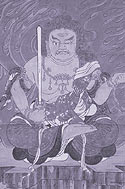:::::::::::::::::::::::::::::::::::::::::::::::::::::::::::::::::::::::::::::::::::::::::::::::::::::
Tokusa Fudo Temple with a Daruma Fair
It is said that "Hibuse-no-Fudo", Hibuse Fudo 火伏不動 protects from fire and theft. The dealers in the outdoors of about 500 shops gather, and Dharma, garden trees, toys, food, etc. are sold on that day.
The Dharma fair which is held at the very end of the New Year Season in the Kanto district.
From 9:00 to around 17:00. January 28, the Day of Fudo.
Shimo-Asao Fudo-in Temple at Asao ward , Kawasaki city
http://www.kanagawa-kankou.or.jp/english/hot_news/0301_news.html
:::::::::::::::::::::::::::::::::::::::::::::::::::::::::::::::::::::::::::::::::::::::::::::::::::::
Asao Fudo Daruma Market
麻生不動だるま市, ダルマ市」
Asao Ward, Kawasaki Town
At the Temple Asao Fudo Hall 麻生不動院


The name Asao is said to originate from the area's agricultural production of hemp, or "asao" in Japanese. It is said that linen cloth made from hemp of the area was offered as tribute to the Imperial Court in the 8th century.
The Daruma Market in Asao, which happens to be the last of all Dharma doll fairs held in Kanto region every year.
source : www.city.kawasaki.jp


. asao 麻紵 麻緒, 麻苧, asahimo 麻紐, asa-ito 麻糸 .
hemp string and threads
asaodana asao-dana 麻苧店 store selling asao hemp thread
asatonya, asadonya 麻問屋 hemp dealer
:::::::::::::::::::::::::::::::::::::::::::::::::::::::::::::::::::::::::::::::::::::::::::::::::::::
不動院は、明王不動院盤若坊と称する真言宗豊山(ぶざん)派の寺院ですが、木賊(とくさ)不動とも呼ばれています。 木賊不動と呼ばれるようになったのは、昔この地が木賊の生い茂る所だったためとか、あるいは村人が木賊ガ原で草を刈っていたときに不動像を発見し、これを祀(まつ)ったからだともいわれています。 不動院の縁日は1月28日で、この日は境内及びその周辺に農機具やおみやげを売る露店のほか、ダルマを売る店が多数出店されますので、「関東の納めダルマ市」と呼ばれています。 不動院の縁日にダルマが売られるようになったのは、明治の終わり頃からで、現在は平塚市四の宮や厚木市でつくられている「相模ダルマ」が中心となっています。
 また、ここの不動様は火伏せの不動としても有名で、縁日に参拝した人は、穴あき銭を1枚もらい、それを火の側に祀っておくと火難にあわないといわれています。そして、1年間無事であった場合は、昨年もらった穴あき銭に御礼のお金を添えて返し、新しい穴あき銭をもらって帰るというしきたりがあります。
また、ここの不動様は火伏せの不動としても有名で、縁日に参拝した人は、穴あき銭を1枚もらい、それを火の側に祀っておくと火難にあわないといわれています。そして、1年間無事であった場合は、昨年もらった穴あき銭に御礼のお金を添えて返し、新しい穴あき銭をもらって帰るというしきたりがあります。http://www.city.kawasaki.jp/88/88bunka/home/top/stop/dokuhon/t0705.htm
xxxxxxxxxxxxxxxxxxxxxxxxxxxxxxxxxxxxxxxxx
木賊不動 Tokusa Fudo

© PHOTO : higefuji
Striking sparks over a Daruma Doll after it is sold, to increase the Good Luck it will bring to the new owner.
Daruma no Hi-uchi 達磨の火打ち

© PHOTO : noriclimber
:::::::::::::::::::::::::::::::::::::::::::::::::::::::::::::::::::::::::::::::::::::::::::::::::::::
hiuchi, hi-uchi 火打ち striking a fire
hiuchi doogu 火打道具 utensils to strike a fire
hiuchi ishi 火打石 flint stone
hiuchi bako 火打箱 / 燧箱 tinder box
hiuchi bukuro 火打ち袋
pouch to keep the fire tools when travelling
hokuchi 火口 tinder, lit. "fire mouth"
To strike fire for good luck (kiribi 切り火)when someone leaves the home for a trip or a dangerous job is a familiar scene from Zenigata Heiji, the detective of the Edo period. The sparks will ward off evil influence and bad luck.
. Zenigata Heiji 銭型平次 and Kanda Myojin
Legend tells of Prince Yamatotakeru (日本武尊) , who had to go on a mission to the North to quell enemies. His aunt gave him a pouch with a flintstone, which saved him in peril on the trip.
Even now you can buy the flint stone as a lucky charm.

Japanese flint stones are made from a kind of quarz glass (sekiei 石英) or from agate (menoo 瑪瑙).
They can be used with a piece of metal to produce sparks (hiuchi gane 火打ち金/燧鉄).
. . . CLICK here for Photos !
Fire can also be made by the more primitive fire drills (momikiri 揉錐 )
- - - - - - - - - -

Hiuchigama (fire beating sickle)
along with the hiuchi ishi (fire beating stone, flintstone) and hokuchi (tinder) were used to light fires in feudal Japan.
© More in the WIKIPEDIA !
hiuchigama 火打ち鎌 tool to strike a fire
hiuchigane 火打ちがね

source and more photos : www.d3.dion.ne.jp/~makiuchi
hiuchigama uri 火打ち鎌売り vendor of tools to strike a fire
The store Masuya 升屋 near Shiba Shinmei 芝神明 shrine sent out his vendors to make business in Edo. They carried an old helmet sign (kabuto 兜) on top of their merchandise as advertisement, because this was the shop sign of Masuya.
Another shop at the postal station Yoshii-juku 吉井宿 also used such a sign. His merchandise was of good quality and soon sold all over Japan.

source : www.jti.co.jp/tobacco-world
. tsukegi 付木 startwood for fire, "match" .
and vendors of these "matches" in Edo
. Doing Business in Edo .
.................................................................................
hiuchi yaki 火打焼 a kind of mochi
from Nara.
Its origin is a sweet from China called Buto ぶと.

In 768, when the shrine Kasuga Taisha was built, the priests of the shrine dress in hunters gear (kariginu 狩衣 ) and pound rice for mochi, which are fried in oil. They are also written 伏兎.
The tea stall near the shrine, Chiyo no sha 千代の舎, began selling them during the Edo period. They were now filled with rough sweet beans (tsubu anko) and grilled on both sides to purify them.
Nowadays they are called gyuuhi mochi 求肥(ぎゅうひ)餅.
. WASHOKU
All kinds of Mochi Ricecakes
:::::::::::::::::::::::::::::::::::::::::::::::::::::::::::::::::::::::::::::::::::::::::::::::::::::
Hibuse Daruma ... 火防達磨
Fire and war preventing Daruma. Temple Junshin-Ji
:::::::::::::::::::::::::::::::::::::::::::::::::::::::::::::::::::::::::::::::::::::::::::::::::::::
H A I K U
tokusa 木賊 (とくさ) horsetail fern, scouring rush
. . . . . 砥草(とくさ)
Equisetum hyemale , Plant. Schachtelhalm
kigo for mid-autumn
tokusa karu 木賊刈る (とくさかる) cutting scouring rush
kigo for late autumn

tokusayama 木賊山(とくさやま) "Tokusa-Mountain"
famous float during the Gion Festival in Kyoto
kigo for late summer
. . . CLICK here for Photos !
:::::::::::::::::::::::::::::::::::::::::::::::::::::::::::::::::::::::::::::::::::::::::::::::::::::

大寒や達磨火打ちで送り出し
daikan ya Daruma hi-uchi de okuridasu
great cold -
with lucky Daruma sparks
I am sent off
Kosuzu
source : snmhaiku.web
:::::::::::::::::::::::::::::::::::::::::::::::::::::::::::::::::::::::::::::::::::::::::::::::::::::

kigo for late spring
sugina 杉菜 (すぎな) field horsetail
tsugimatsu 接ぎ松(つぎまつ)
inusugina, inu sugina 犬杉菜(いぬすぎな)"dog field horsetail"
Equisetum arvense
It grows wild from Hokkaido to Kyushu.
すさまじや杉菜ばかりの丘一つ
susamaji ya sugina bakari no oka hitotsu
how overwhelming !
a whole hill full of
field horsetail
. Masaoka Shiki 正岡子規 .
:::::::::::::::::::::::::::::::::::::::::::::::::::::::::::::::::::::::::::::::::::::::::::::::::::::
. Tsukushi 土筆(つくし)horsetail plant .
fude no hana, "brush flower" 筆の花(ふでのはな)
picking horsetail plants, tsukushi tsumi 土筆摘(つくしつみ)
Equisetum (horsetail, snake grass, puzzlegrass)
is the only living genus in the Equisetaceae, a family of vascular plants that reproduce by spores rather than seeds.
© More in the WIKIPEDIA !
:::::::::::::::::::::::::::::::::::::::::::::::::::::::::::::::::::::::::::::::::::::::::::::::::::::
[ . BACK to WORLDKIGO TOP . ]
[ . BACK to DARUMA MUSEUM TOP . ]
:::::::::::::::::::::::::::::::::::::::::::::::::::::::::::::::::::::::::::::::::::::::::::::::::::::












































